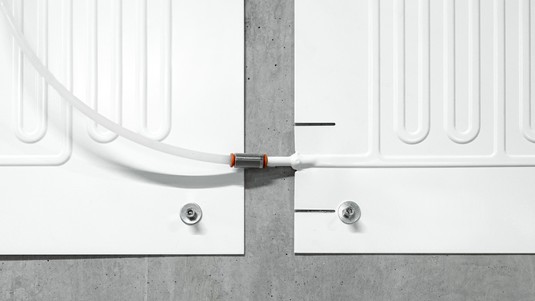Rethinking Renewables: Enerdrape's Underground Energy Revolution

The Enerdrape team
Solar and wind may lead the renewable conversation, but Enerdrape is quietly transforming the game underground. We dive into this innovation with CEO Margaux Peltier and Professor Lyesse Laloui to explore how their geothermal tech is reshaping urban energy: no sunlight, no drilling, just smart science.
When we think of renewable energy, it is usually solar panels on rooftops and wind turbines in fields that dominate the narrative. However, there is a powerful, constant and often overlooked resource beneath our feet: geothermal energy. Unlike wind or solar energy, it is not dependent on the weather or daylight. Now, thanks to the Swiss start-up Enerdrape, this source is finally being incorporated into the built environment without the need for drilling or major construction.
Founded by Margaux Peltier, Alessandro Rotta Loria and Lyesse Laloui as an EPFL spin-off, Enerdrape develops ultra-thin panels that transform the walls of underground spaces, such as car parks, tunnels and basements, into clean energy exchangers. Just 2 cm thick, these panels circulate a fluid in a closed loop, absorbing low-grade heat from the surrounding concrete and air. This energy is then amplified by a heat pump and used for heating in winter and cooling in summer. With each square metre of panel supporting around 10 square metres of indoor space, the system offers a flexible, low-impact way to reduce emissions from building infrastructure.
“We don’t drill—we use what’s already there,” Peltier explains. “That’s what makes this technology so powerful, especially in cities where the potential is huge, but access is limited.”
Enerdrape’s story began not in a startup incubator, but in a research lab. As a master’s student at the Laboratory of Soil Mechanics at EPFL, Peltier joined a project led by Professor Lyesse Laloui, a pioneer in the field of geothermal structures. Laloui had been working for decades on the science behind underground energy systems and, along with co-inventor Rotta Loria, had developed and patented the panel concept in 2020. While contributing to the project during her thesis, Peltier quickly moved beyond the scope of her academic assignment. Engaging with both the technical and practical dimensions of the work, she began to see the untapped potential of turning the research into a real-world product.
“At first, I didn’t even consider becoming an entrepreneur,” she says. “But while writing the research article, I started to get really involved. I realized this had real potential, and I wanted to see where it could go.”
According to Laloui, seeing that potential is only the beginning. “Success in this space requires more than good science. You need to master certification, the market, and the human side—team dynamics, fundraising, credibility. Margaux understood that early.”
The decision to take the leap wasn’t made without hesitation. However, as Margaux puts it, “The best moment is just after graduating. You’re used to learning quickly, you don’t have much to lose, and you gain so much experience — even if it doesn't work out.' What began as an extension of his academic work quickly evolved into a venture with a clear product vision.
As the idea gained traction, institutional support played a quiet but essential role. EPFL’s Technology Transfer Office (TTO) helped with managing intellectual property, negotiating licensing terms and identifying early funding opportunities. This support helped to structure the transition from research to real-world application, enabling Peltier and her team to take the lead in shaping the business.
With funding from public innovation grants such as Innosuisse Bridge, Innoseed and Enable, Enerdrape began building its operational foundations by hiring its first team members, iterating on prototypes and validating its technology in the field.
By 2023, Enerdrape had been commercially launched. Now based in Renens, the start-up employs five people and is growing steadily. It has already secured clients across Switzerland, including Coop and major real estate groups, and is now active in France, with installations underway in Paris. The panels are being adapted to local technical requirements and certification standards, enabling the technology to be scaled up beyond its initial market.
"We're in a scaling phase now," says Peltier. ‘We have a working version, and we’re adapting it for different environments so we can grow both sustainably and quickly.’
The path hasn’t always been straightforward, though. The pandemic caused delays, and as a young woman leading a technical venture, Peltier sometimes had to work harder to establish credibility. Peltier approached this by consistently demonstrating the reliability of the technology and the strength of the underlying research, letting the work speak for itself.
Laloui continues to advise the company. To him, Enerdrape reflects the successful transition from scientific research to practical implementation. "We hope that these panels will be normal for underground spaces, like solar panels are for roofs."
Although Enerdrape is still in its early stages, it is a powerful example of how science, strategy and courage can come together to turn research into meaningful impact. With the right mix of curiosity, resilience and support, it shows that impactful sustainability can happen even where we don't see it.



